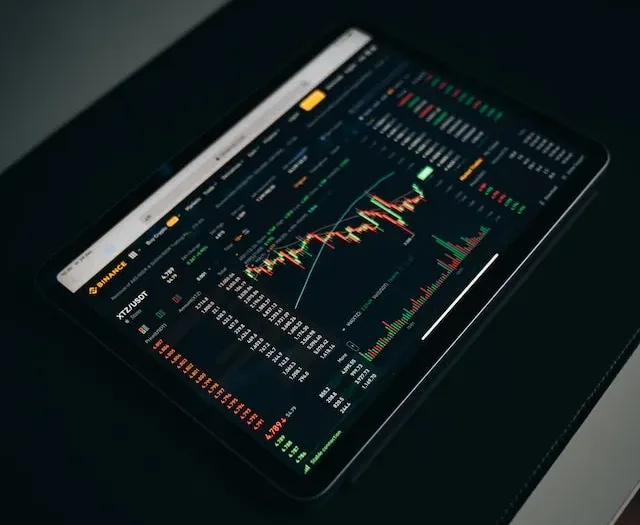Imagine a quiet evening sky, where the twinkling stars start to emerge, each with its own story to tell. Among them appears the evening star, known in the world of trading as the bearish counterpart of the morning star pattern. This star-like pattern derives its name from a celestial wonder – Venus, the evening star – which graces the sky just before nightfall.
Evening Star Candlestick Pattern: A Top Reversal Signal
The evening star candlestick pattern, much like its luminous counterpart in the cosmos, has its own significance in the financial world. When this pattern unfolds after a period of rising prices, it acts as a signal of potential change. Just as dusk signals the end of the day, the evening star candlestick pattern suggests a possible shift from an uptrend to a downward movement in market prices.
Picture this pattern as a trio of lines, each representing a phase of market sentiment. The first is a bullish candle, representing the prevailing upward trend. Then, a small-bodied candle follows, indicating uncertainty. Finally, a bearish candle arrives, casting a shadow on the preceding optimism and hinting at a potential shift toward a bearish trend.
In essence, the evening star candlestick pattern can be seen as a conversation between market forces. It urges traders to be cautious, as the optimism that once prevailed might be giving way to doubt. Remember, it’s not just lines on a chart – it’s a tale of transition, a story of shifting tides in the vast sea of trading.
The Evening Star Candlestick Pattern in Action
Imagine a relay race, where the baton passes from one runner to the next, each carrying a unique message. Let’s apply this analogy to the evening star candlestick pattern, which plays a similar role in conveying shifts within the trading landscape.
Bullish Green Candle (The First Runner)
Picture the first runner with the baton representing a time of positivity, much like an uptrend in trading. This occurrence can be referred to as a “bullish white real body”. Think of it like the start of a race, where everyone is full of energy and excitement. It’s similar to how things kick off when the race begins suddenly.
Star Candlestick (The Second Runner)
Now, visualize the second runner pausing for a moment before receiving the baton. This can be likened to a star-shaped candle in trading. It mirrors a brief hesitation, reflecting doubts that may arise after a robust uptrend. It’s akin to the second runner hesitating before starting their leg of the race.
Bearish Red Candle (The Last Runner)
And finally, imagine the last runner taking the baton and dashing towards the finish line. This runner is like a “black real body” in the evening star candlestick pattern, giving us a heads-up about possible changes coming up. Just like the runner’s speed decreases after getting the baton, the earlier positivity in the market also starts to ease up.
Decrypting the Evening Star Candlestick Pattern’s Characteristics
When it comes to identifying the evening star candlestick pattern, certain key characteristics come into play. Let’s delve into these features that help us understand this pattern’s potential impact on trading trends.
In its essence, an ideal evening star pattern displays gaps between the real bodies of the first and second candlesticks, as well as between the second and third ones. However, based on our experience, observing the second gap is a rarity and isn’t crucial for the pattern’s success. What truly matters is how much the third day’s black real body intrudes into the first day’s white real body.
Key Reversal Factors
Several factors contribute to the likelihood of an evening or morning star pattern marking a reversal. These elements offer insight into potential changes in market sentiment and direction:
Gap Arrangement
A significant consideration involves gaps within the pattern. If gaps appear between the first candlestick’s real body and the star’s real body, and further between the star’s and the third candlestick’s real bodies, the pattern gains strength.
Deep Closure
Another factor to note is the closure of the third candlestick into the first candlestick’s real body. A deep closure signals a stronger potential for reversal, as it suggests a shift in momentum.
Volume Dynamics
Observing volume patterns is crucial. A situation where the first candlestick session records light volume and the third candlestick session sees heavy volume implies a decrease in the previous trend’s force and an increase in the new trend’s momentum.
By considering these key factors, traders can enhance their ability to recognize potential reversals signified by the evening star pattern. It’s more than just patterns on a chart; it’s about interpreting the story they tell and using that insight to make informed trading choices.
Navigating Evening Star Signals
As we delve into understanding evening star signals, we’re uncovering some valuable insights into how they can impact trading trends. By exploring the gaps, the depth of closures, and the way volume behaves, we’re setting ourselves up to understand how evening star patterns affect trading.
Conclusion: Guiding You Through Market Changes
Just like people once used the stars to find their way, traders use patterns like the evening star to guide their decisions in the trading world. Even though they might look like simple candlesticks, they’re telling a story of possible changes in the market.
By learning about the evening star – what it’s made of and what it means – you’re getting a tool to help you guess where the market might go. It’s not just about patterns; it’s like having a conversation with the market, learning when it might change its mind.
As you keep trading, think of the evening star as a little helper, showing you hints about what might happen next. Just like people used stars to travel safely, you can use the evening star pattern to make smarter trading choices.
And if you want to learn even more about trading, “The Market Technicians” is there to help you explore and understand the trading world better. With that, we finish up our journey into the evening star candlestick pattern, leaving you with its light to guide you through your future trades.
Frequently Asked Questions about Evening Star Patterns
Is the second gap important in the evening star candlestick pattern?
The second gap is often talked about, but don’t stress if it’s missing. What really matters is how much the black real body goes into the white real body of the first candlestick.
Can a deep closure between the third and first candlesticks predict a reversal?
It’s a good hint, but don’t rely only on that. Look at other things too, like how the gaps are arranged and how the volume changes.
Why does volume matter in the evening star candlestick pattern?
Think of volume like how many people are getting involved in trading. When it starts low and gets high, it could mean a change in the market’s direction.
Do evening star patterns work in all types of markets?
Yes, you can see these patterns in different markets, whether it’s stocks, forex, cryptocurrencies, or other things people trade.
Affiliate link disclaimer: Some links in this article may earn us a commission for any resulting purchases. Thank you for supporting our content.








Wow, awesome weblog layout! How lengthy have you ever
been running a blog for? you make blogging glance easy.
The overall look of your web site is wonderful,
let alone the content! You can see similar here sklep online